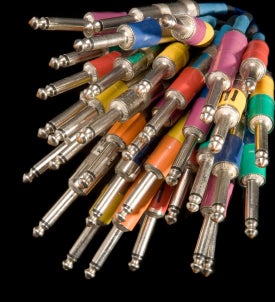Gadgetry’s Golden Rule
"Buy the cheap cables": Remember these words and thou shalt never be ripped off

We may earn revenue from the products available on this page and participate in affiliate programs. Learn more ›
For the vast majority of us, few are the occasions when our opinions matter in any meaningful way. Say what you will about the importance of teaching your children, or being in charge of your office budget or participating in the voting process, but the sad reality is that your wisdom is an underutilized asset… except when it comes to your tech savvy. If you’re reading this, it’s your responsibility to go out in the world and evangelize against the temptations of bad tech gear.
I recently found myself failing in this regard, after a friend made a big ticket purchase without my counsel. Eager to spend her annual bonus on an HDTV, she made a trip to her local Best Buy before speaking with me, and I can only blame myself that I didn’t get to her sooner. The LCD she bought was reasonable enough—not one I’d pick, mind you—but what got me was that she fell victim to the cable up-sell. It’s the biggest scam there is. So 180 bucks and a fistful of overpriced plastic-wrapped copper later, I’m shaking my head and she’s soured on her purchase, which is a shame.
Much has been written and debated about the cable question, so in light of my friend’s recent misfortune, I’d like to speak plainly and settle the question once and for all. For the record: Pricey, so-called high-end cables and wiring—speaker, HDMI, DVI, Firewire, RCA, USB, you name it—no matter what, are an out-and-out scam.
I know you audiophiles out there are now taking off your $3000 walnut-core, gold-plated headphones and putting out a call on your analog phones to form a lynch mob—but hear me out. The electronics industry’s dirty little secret is that they have extremely thin margins on gear, so they make up the cost difference by up-selling you on extended warranties and incredibly marked-up cables.
Lest I be accused of comparing apples to oranges, or analog to digital, let me concede that when it comes to speaker wire, you should pay attention to gauge and maybe take shielding into consideration. But that’s it. Go get your next speaker wire at Home Depot and save yourself a few hundies. As for digital, certainly some cables may be constructed to be a little more rugged, which if you’re plugging and unplugging your cables a few times a day—which precisely no one does—then their higher build quality may merit a few extra dollars in price. A few dollars.
However, an $8 HDMI cable is as good as any other—for instance this $220 beauty from Monster. One digital signal (it’s just ones and zeros!) works exactly like any other digital signal. Manufacturers will show you oscilloscopes attempting to prove otherwise, and speak of bandwidth and nitrogen-infusions and gold-plating and precious herbs and berries, but that’s all complete nonsense. The human eye (and ear, for that matter) can’t tell the difference and anyone telling you otherwise is selling something—like these $7250 speaker cables.
Consider this the Golden Rule of gadgetry, and make sure your friends hear it. I’ll enjoy reading comments from audio- and videophiles defending their ridiculous purchases, as well as other buying suggestions and possible scams to watch out for.